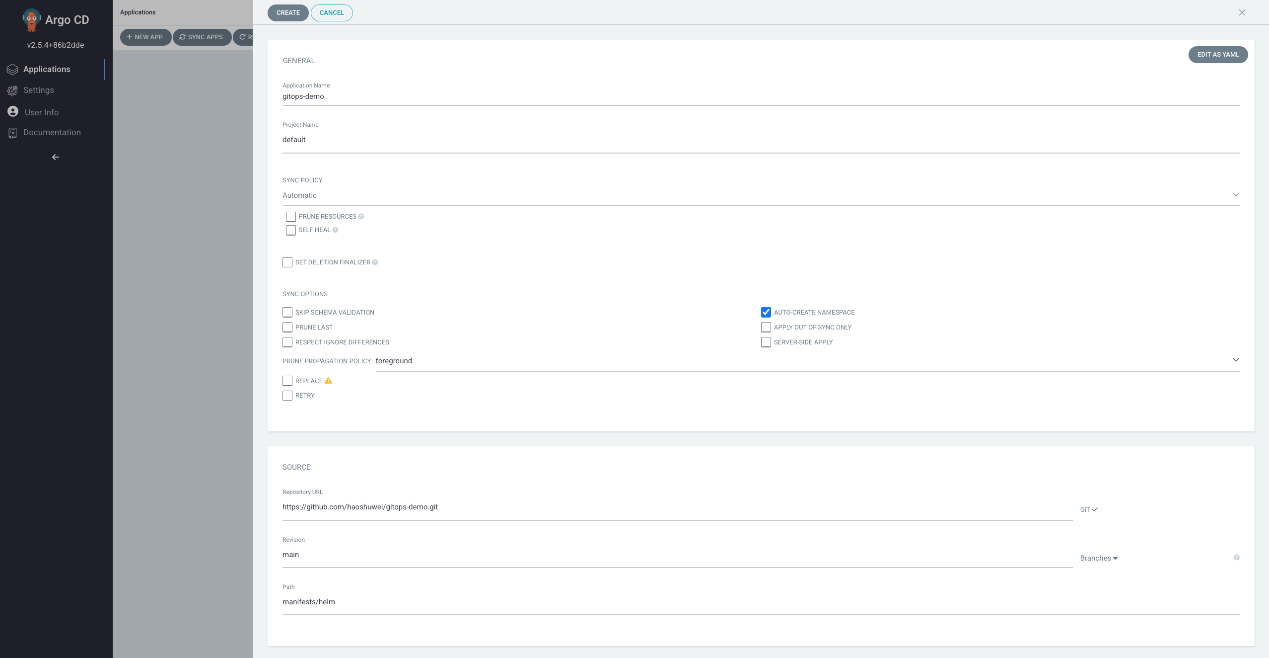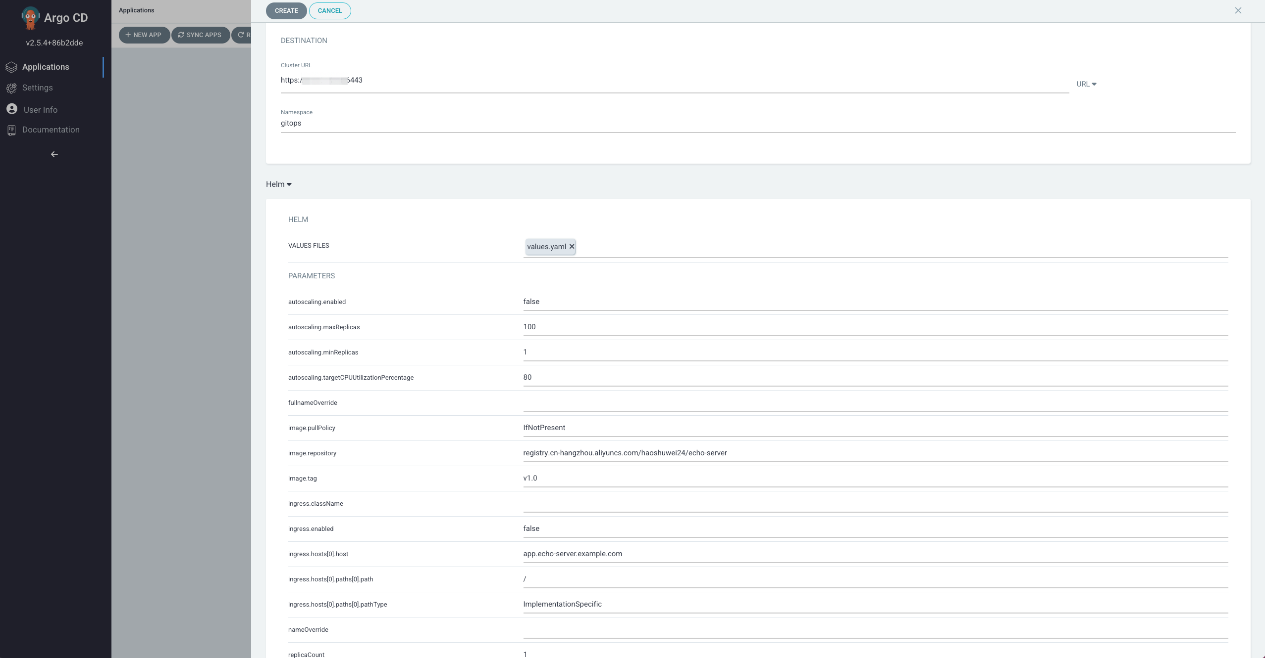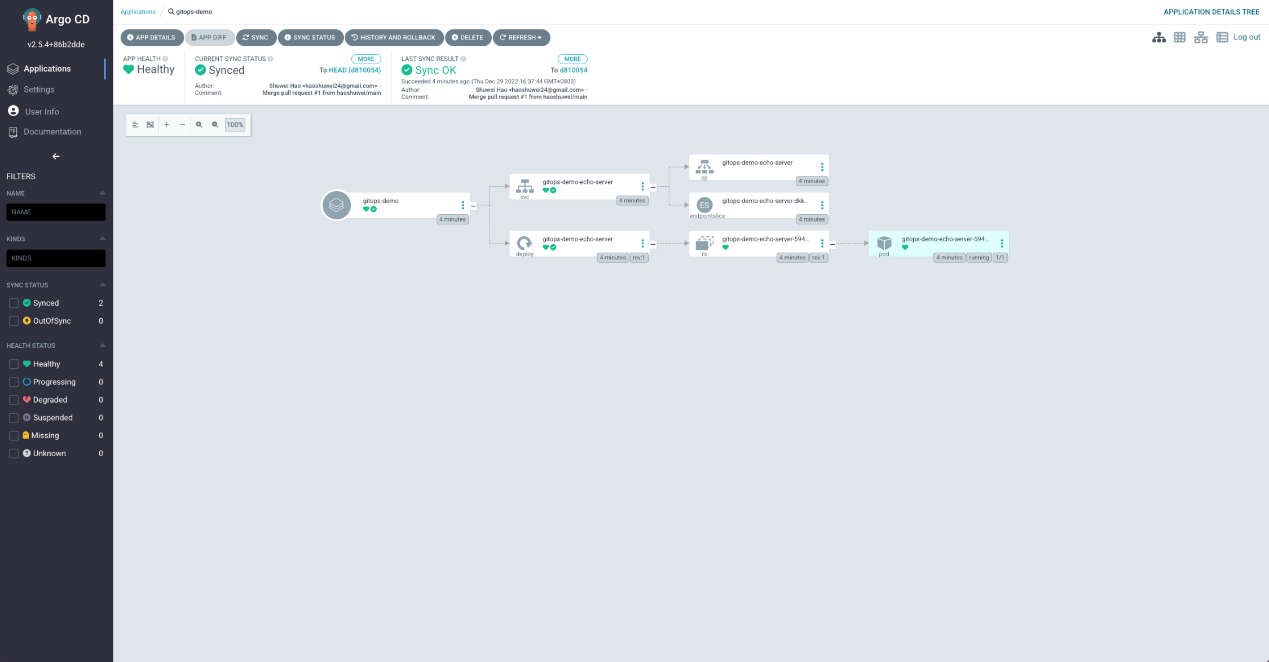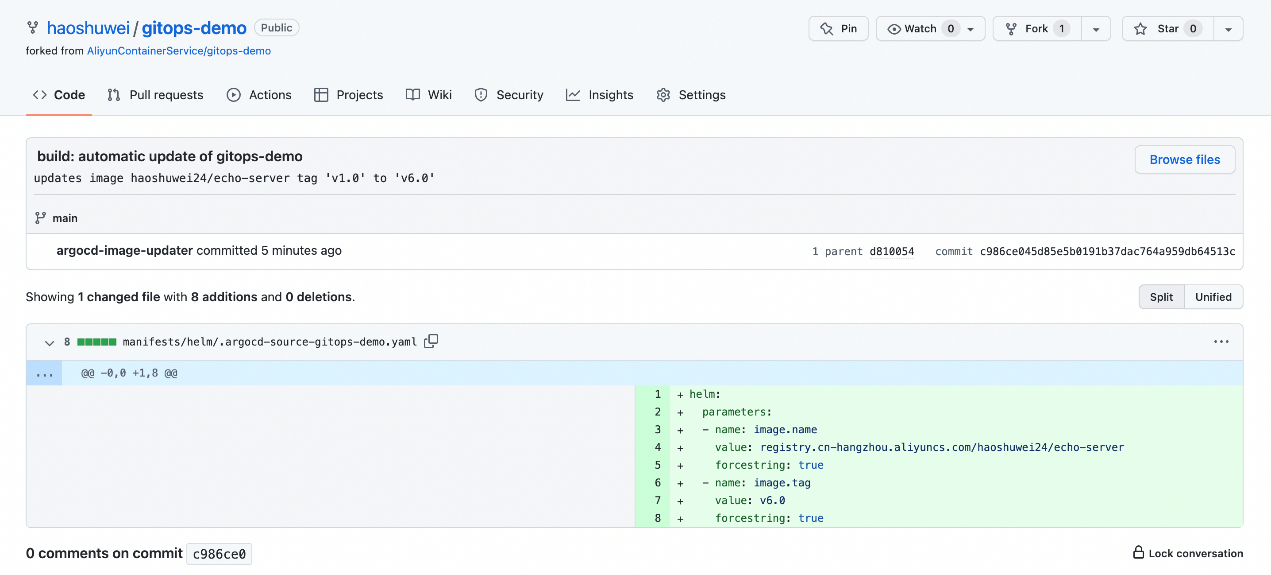By Liusheng
You can use a third-party Continuous Integration (CI) system to complete the following CI pipeline:

After the CI system pushes a container image of an application to an ACR image repository, the Continuous Delivery (CD) pipeline is triggered, and the container image of the application is updated. This example mainly demonstrates how ACK One GitOps automatically listens for ACR image repository changes. If there is a container mirror tags update that meets the filtering conditions, the following process will be triggered:

The GitHub address of the sample application in this article: https://github.com/AliyunContainerService/gitops-demo.git
In this example, the application changes are written back to the Git repository. Therefore, you need to fork the Git repository to your account first. For example, this demonstration will use the following repository address: https://github.com/haoshuwei/gitops-demo.git
The directory structure of the gitops-demo application is:
.
├── manifests
│ └── helm
│ ├── Chart.yaml
│ ├── templates
│ │ ├── deployment.yaml
│ │ ├── _helpers.tpl
│ │ ├── hpa.yaml
│ │ ├── ingress.yaml
│ │ ├── NOTES.txt
│ │ ├── serviceaccount.yaml
│ │ ├── service.yaml
│ │ └── tests
│ │ └── test-connection.yaml
│ ├── values-oversea.yaml
│ └── values.yaml
└── README.mdIn the values.yaml file, the image tag used to dynamically render the application lock by image.tag:
image:
repository: registry.cn-hangzhou.aliyuncs.com/haoshuwei24/echo-server
pullPolicy: IfNotPresent
# Overrides the image tag whose default is the chart appVersion.
tag: "v1.0"Please see this link for more information about how to connect to and access the GitOps system.
Add a Git source repository. Please see this link for more information.
Application creation reference: https://www.alibabacloud.com/help/en/container-service-for-kubernetes/latest/gitops-management
(1) Create CLI: create application gitops-demo. Please check below for more information about the parameters:
argocd app create gitops-demo --repo https://github.com/AliyunContainerService/gitops-demo.git --path manifests/helm --dest-namespace gitops --dest-server https://xx.xx.XX.XX:6443 --sync-policy noneargocd app sync gitops-demo(2) Create UI: create application gitops-demo.
Please see the following two figures for more information about the parameters:


View the running status of the application:

When you push a new version of an application image to the ACR image repository, you want the GitOps system to automatically detect the new version and update it to the actual environment. Before you configure automatic application updates, you need to know the following content:
(1) View the Application CR of the gitops-demo:
$ kubectl -n argocd get application gitops-demo -oyaml
apiVersion: argoproj.io/v1alpha1
kind: Application
metadata:
name: gitops-demo
namespace: argocd
spec:
destination:
namespace: gitops
server: https://x.xxx.xxx.x:6443
project: default
source:
helm:
valueFiles:
- values.yaml
path: manifests/helm
repoURL: https://github.com/haoshuwei/gitops-demo.git
targetRevision: HEAD
syncPolicy:
automated: {}
syncOptions:
- CreateNamespace=true(2) Add annotations for the gitops-demo
Generate imageUpdate.patch:
$ cat <<EOF > imageUpdate.patch
metadata:
annotations:
argocd-image-updater.argoproj.io/image-list: echoserver=registry.cn-hangzhou.aliyuncs.com/haoshuwei24/echo-server
argocd-image-updater.argoproj.io/echoserver.helm.image-tag: image.tag
argocd-image-updater.argoproj.io/echoserver.update-strategy: semver
argocd-image-updater.argoproj.io/echoserver.allow-tags: regexp:^v[1-9].*
argocd-image-updater.argoproj.io/write-back-method: git:secret:argocd/git-creds
EOFAdd annotations to the gitops-demo:
$ kubectl -n argocd patch Application gitops-demo --type=merge -p "$(cat imageUpdate.patch)"(3) Configure credentials for accessing ACR and Git repositories
Configure credentials for accessing ACR:
$ kubectl -n argocd apply -f - <<EOF
apiVersion: v1
kind: Secret
metadata:
name: acr
type: Opaque
stringData:
acr: <your_username>:<your_password> # Replace <your_username>:<your_password> with the credentials of your image repository.
EOFConfigure credentials for accessing the Git repository:
$ kubectl -n argocd create secret generic git-creds \
--from-literal=username=<your_username> \
--from-literal=password=<your_password>(1) Push the new image tag to the ACR image repository:
$ docker pull registry.cn-hangzhou.aliyuncs.com/haoshuwei24/echo-server:v1.0
$ docker tag registry.cn-hangzhou.aliyuncs.com/haoshuwei24/echo-server:v1.0 registry.cn-hangzhou.aliyuncs.com/haoshuwei24/echo-server:v2.0
$ docker push registry.cn-hangzhou.aliyuncs.com/haoshuwei24/echo-server:v2.0(2) Run the following command to view the logs of argocd-image-updater containers in the argocd namespace:
$ kubectl -n argocd logs -f argocd-server-xxxxxxxxxx-xxxxx -c argocd-image-updaterExpected output:
time="2022-12-29T09:58:13Z" level=info msg="Successfully updated the live application spec" application=gitops-demo
time="2022-12-29T09:58:13Z" level=info msg="Processing results: applications=1 images_considered=1 images_skipped=0 images_updated=1 errors=0"Check whether the application image in the destination cluster is automatically updated.
(3) Check whether the manifests/helm/.argocd-source-gitops-demo.yaml file is automatically generated in the Git repository on GitHub (indicating that the Git write-back is successful).

You can set the annotation to mark one or more container images for an application created in the GitOps system to be automatically updated. You must set annotations in the following format:
argocd-image-updater.argoproj.io/image-list: <image_spec_list>It can be a single container image or a group of container image lists separated with commas (,). You must specify container images in the following format:
[<alias_name>=]<image_path>[:<version_constraint>]It is the container image alias of the application, so it can be referenced when making other configurations. Aliases can only contain alphanumeric strings and can only be used in the annotations of image-list. In this example, the image to be automatically updated is specified as registry.cn-hangzhou.aliyuncs.com/haoshuwei24/echo-server, and the alias set for it is echoserver:
argocd-image-updater.argoproj.io/image-list: echoserver=registry.cn-hangzhou.aliyuncs.com/haoshuwei24/echo-serverLet’s take registry.cn-hangzhou.aliyuncs.com/haoshuwei24/echo-server images as an example. You can set filter conditions to automatically update the application only when the echo-server images in the ACR image repository have new tags that meet the filter rules.
The following filter condition allows only tags that match the regular expression to trigger image updates:
argocd-image-updater.argoproj.io/<image_name>.allow-tags: <match_func>The format is regexp:, which is the standard regular expression.
The following example describes the standard regular expression:
argocd-image-updater.argoproj.io/echoserver.allow-tags: regexp:^v[1-9].*The following table describes the container image update policies that you can configure. The default container image update policy is semver.
| Update Policy | Description |
| semver | Update to the latest image version in a list that is sorted based on semantic versions |
| latest | Sort by creation time and update to the latest image tag (Note: Not the time when the image was pushed to the repository) |
| name | Update to the latest image version in an alphabetically sorted list |
| digest | Update to the latest image version pushed with a mutable tag |
The annotation used to specify a container image update policy must be in the following format:
argocd-image-updater.argoproj.io/<image_name>.update-strategy: <strategy>The following example shows that the image update policy used is semver:
argocd-image-updater.argoproj.io/echoserver.update-strategy: semverAn application may contain descriptions of multiple container images. For example, the values.yaml file applied by gitops-demo contains image.repository image.tag configurations. The following format describes the configurations of Annotations:
annotations:
argocd-image-updater.argoproj.io/image-list: echoserver=registry.cn-hangzhou.aliyuncs.com/haoshuwei24/echo-server
argocd-image-updater.argoproj.io/echoserver.helm.image-name: image.repository
argocd-image-updater.argoproj.io/echoserver.helm.image-tag: image.tagImage update annotation for applications whose manifests are rendered and managed by using Kustomize: You must specify the aliases of the new images and the addresses of the original images. You can include image tags in image aliases but cannot include image tags in image addresses. The annotation must be in the following format:
annotations:
argocd-image-updater.argoproj.io/image-list: <image_alias>=<image_name>:<image_tag>
argocd-image-updater.argoproj.io/<image_alias>.kustomize.image-name: <original_image_name>You must configure the following access credential to use GitOps to automatically monitor changes in the ACR image repository and update the application. Configurations related to the ACR image repository are stored in a ConfigMap named argocd-image-updater-config in the argocd namespace.
View the default configuration through the following format:
$ kubectl -n argocd get cm argocd-image-updater-config -oyaml
apiVersion: v1
data:
registries.conf: |
registries:
- name: AlibabaCloud Container Registry
api_url: https://registry-vpc.<RegionID>.aliyuncs.com
prefix: registry-vpc.<RegionID>.aliyuncs.com
insecure: no
credentials: secret:argocd/acr#acr
kind: ConfigMap
metadata:
labels:
app.kubernetes.io/name: argocd-image-updater-config
app.kubernetes.io/part-of: argocd-image-updater
name: argocd-image-updater-config
namespace: argocd| Parameter | Description |
| name | The name of the image repository |
| api_url | The API address of the container image repository. is automatically generated based on dynamic rendering in the current region. |
| prefix | The query prefix of the container image repository. The prefix is automatically generated based on dynamic rendering in the current region. |
| credentials | The query prefix of the container image repository. When the system installs GitOps, the system automatically generates the prefix based on the region where GitOps is installed. |
If you are using an ACREE image repository, replace the values of the api_url and prefix fields.
According to the credentials: secret:argocd/acr#acr configuration, we need to create a secret named acr in the argocd namespace to store the credentials for accessing the ACR image repository:
kubectl -n argocd apply -f - <<EOF
apiVersion: v1
kind: Secret
metadata:
name: acr
type: Opaque
stringData:
# Replace <your_username >:< your_password> with your container image repository access credential.
acr: <your_username>:<your_password>
EOFIf you configure the username and password when you add a Git Repository to the GitOps system, the application that uses the Git Repository has permission to write back the change information of the application container image to the Git system by default. You can add the following annotations to configure the Git credential:
annotations:
argocd-image-updater.argoproj.io/write-back-method: gitIf you need to customize the Git credential, you can use the specified Git credential by adding the following annotations:
annotations:
argocd-image-updater.argoproj.io/write-back-method: git:secret:argocd/git-credsAnd create a secret named git-creds under the argocd namespace:
$ kubectl -n argocd create secret generic git-creds \
--from-literal=username=<your_username> \
--from-literal=password=<your_password>Please visit this link for more image-updater usage.
Event-driven Practice of Knative: Trigger Events Through EventBridge

182 posts | 32 followers
FollowAlibaba Container Service - August 1, 2023
Alibaba Cloud Native - May 23, 2023
Alibaba Container Service - September 19, 2024
Alibaba Container Service - October 13, 2022
Alibaba Container Service - December 5, 2024
Alibaba Container Service - May 16, 2024

182 posts | 32 followers
Follow Best Practices
Best Practices
Follow our step-by-step best practices guides to build your own business case.
Learn More ACK One
ACK One
Provides a control plane to allow users to manage Kubernetes clusters that run based on different infrastructure resources
Learn More Container Service for Kubernetes
Container Service for Kubernetes
Alibaba Cloud Container Service for Kubernetes is a fully managed cloud container management service that supports native Kubernetes and integrates with other Alibaba Cloud products.
Learn More Cloud-Native Applications Management Solution
Cloud-Native Applications Management Solution
Accelerate and secure the development, deployment, and management of containerized applications cost-effectively.
Learn MoreMore Posts by Alibaba Container Service